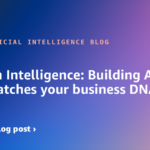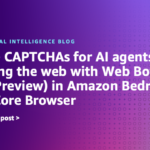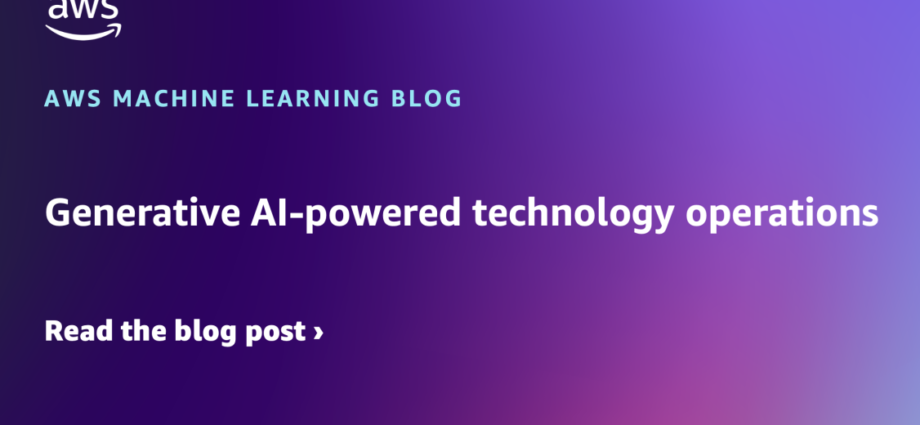Technology operations (TechOps) refers to the set of processes and activities involved in managing and maintaining an organization’s IT infrastructure and services. There are several terminologies used with reference to managing information technology operations, including ITOps, SRE, AIOps, DevOps, and SysOps. For the context of this post, we refer to these terminologies as TechOps. This includes tasks such as managing servers, networks, databases, and applications to maintain reliability, performance, and security of IT systems. However, certain tasks require manual and repetitive efforts such as incident detection and response, analyzing incoming tickets from disparate service providers, finding standard operating procedures for known and unknown issues, and managing support case resolution. In recent years, TechOps has been using AI capabilities—called AIOps—for operational data collection, aggregation, and correlation to generate actionable insights, identity root causes, and more.
This post describes how AWS generative AI solutions (including Amazon Bedrock, Amazon Q Developer, and Amazon Q Business) can further enhance TechOps productivity, reduce time to resolve issues, enhance customer experience, standardize operating procedures, and augment knowledge bases. The ability of generative AI technology to interpret complex situations on a nuanced, case-by-case basis implies that generative AI can solve challenges that other approaches—including traditional artificial intelligence and machine learning (AI/ML)-based pattern matching—couldn’t handle. The following table depicts a few examples of how AWS generative AI services can help with some of the day-to-day TechOps activities.
| Amazon Bedrock | Amazon Q Developer | Amazon Q Business |
| Root cause analysis | Maintenance tasks code generation | Standard operating procedure |
| Knowledge base creation | Increase productivity and efficiency | Organization policy and procedure |
| Recurring reporting | . | Customer experience and sentiment analysis |
| Outbound support case generation | . | Shift handover chatbot |
| Inbound maintenance notifications formatting | . | . |
A typical day in the life of a TechOps team includes issue resolution, root cause analysis, maintenance activities, and updating knowledge bases to provide a positive customer experience. In the following sections, we discuss some of these areas and how generative AI can help enhance TechOps.
Event management
By monitoring systems and analyzing patterns in performance data, an AI model can predict issues before they cause outages or degraded service. When incidents do occur, generative AI models can generate preliminary documentation of the event, including details on impacted systems, potential root causes, and troubleshooting steps. This allows engineers to quickly get up to speed on new incidents and accelerate response efforts.
Generative AI can also generate summary reports of past incidents to help teams identify recurring problems and opportunities for preventative measures. Furthermore, it can help with formatting inbound maintenance notifications from various service providers into a standard format, which can speed up understanding the impact of upcoming maintenance. Similarly, generative AI can automatically generate outbound cases to service providers if it detects an anomaly.
By taking over basic documentation and prediction tasks, generative AI can help infrastructure teams spend less time on repetitive work and more time resolving issues to improve overall system reliability.
To learn more about using Amazon Bedrock for summary tasks, refer to Create summaries of recordings using generative AI with Amazon Bedrock and Amazon Transcribe. To learn how Wiz uses Amazon Bedrock to address security risks, see How Wiz is empowering organizations to remediate security risks faster with Amazon Bedrock. To learn how HappyFox uses Anthropic Claude in Amazon Bedrock, refer to HappyFox Automates Support Agent Responses with Claude in Amazon Bedrock, Increasing Ticket Resolution by 40%.
Knowledge base management
Generative AI has the potential to help engineers automatically create operational documents such as standard operating procedures (SOPs) and supplemental documents, such as server hardening, security policies for external IPs allow lists and operating system patching, and more.
Using natural language models trained on large datasets of existing SOPs and similar content, generative AI systems can understand the common structure and language used in these types of documents. Engineers can then provide the system with high-level requirements or parameters for a new procedure, and generative AI can automatically generate a draft document formatted with the appropriate sections, level of detail, and terminology. This allows engineers to spend less time on documentation and more time focused on other engineering tasks. The initial drafts from AI also provide a strong starting point that engineers can refine.
Overall, generative AI offers a more efficient way for engineers to develop standardized procedural content at scale.
To learn how to use Amazon Bedrock to generate product descriptions, see Automating product description generation with Amazon Bedrock. Additionally, refer to How Skyflow creates technical content in days using Amazon Bedrock to learn how Skyflow Inc.—a data privacy company—uses Amazon Bedrock to streamline the creation of technical content, reducing the process from weeks to days while maintaining the highest standards of data privacy and security.
Automation
Generative AI can assist engineers and automate certain tasks that would otherwise require manual work. One area this could help in is script code generation for repetitive automation processes. By training AI models on large datasets of existing code examples for common programming tasks like file operations or system configuration, generative models can learn patterns and syntax.
An Amazon Q customization is a set of elements that enables Amazon Q to provide you with suggestions based on your company’s code base. Engineers can then provide high-level descriptions or specifications of what they need automated, such as “Generate a script to back up and archive files older than 30 days in this directory.” The AI model would be able to produce working code to accomplish this automatically based on its training. This would save engineers considerable time writing and testing scripts for routine jobs, allowing them to focus on more creative and challenging aspects of their work. As generative AI techniques advance, more complex engineering automation may also be achieved.
Refer to Upgrade your Java applications with Amazon Q Code Transformation to learn about the Amazon Q Code Transformation feature. Also, refer to Using Amazon Bedrock Agents to interactively generate infrastructure as code to learn how to configure Amazon Bedrock Agents to generate infrastructure as code. Lastly, refer to TymeX Accelerates Clean Coding by 40% by Implementing Generative AI on AWS to learn how TymeX uses generative AI on AWS.
Customer experience
Generative AI can analyze large volumes of customer service data, like call logs and support tickets, and identify patterns in issues customers frequently report. This insight allows operations teams to proactively address common problems before they severely impact customers. Generative AI assistants can also automate many routine service tasks, freeing up human agents to focus on more complex inquiries that require personalization. With AI assistance, infrastructure services can be restored more quickly when outages occur. This helps make sure operations are more efficient and transparent, directly enhancing the experience for the customers that infrastructure teams aim to support.
Amazon Q Business offers a conversational experience with generative prompts and tasks that can act as a front-line support engineer, answering customer questions and resolving known issues efficiently. The feature can use data from enterprise systems to provide accurate and timely responses, reducing the burden on human engineers and improving customer satisfaction.
With Amazon Bedrock, you can perform sentiment analysis to help analyze customer emotions and provide context to human engineers, enabling them to provide better support and improve customer loyalty, retention, and growth.
Staff productivity
An all-day infrastructure operations team faces challenges in maintaining staff productivity during off-hours and nights when the volume of support requests is lower. A generative AI assistant can help improve staff productivity in these periods and streamline the shift-handover process.
The assistant can be trained on historical support conversations to understand and resolve a large percentage of routine queries independently. It can communicate with customers on messaging platforms to provide instant assistance. Simple requests that the assistant can address free up the team to focus on complex issues requiring human expertise. The AI system can escalate any queries it can’t resolve on its own to the on-call staff. This allows the night and weekend crew to work with fewer interruptions. They can work through tasks more efficiently knowing the assistant is handling basic support needs independently. Generative AI-powered contact center solutions can improve an agent’s ability to interact with customers more precisely and speed up issue resolution, increasing overall productivity.
To learn how to automate document and data retrieval for AI assistants, see Automate chatbot for document and data retrieval using Amazon Bedrock Agents and Knowledge Bases. Refer to How LeadSquared accelerated chatbot deployments with generative AI using Amazon Bedrock and Amazon Aurora PostgreSQL to learn how LeadSquared uses Amazon Bedrock and Amazon Aurora PostgreSQL-Compatible Edition to deploy generative AI-powered assistants on their Converse platform, which personalize interactions based on customer-specific training data. This integration reduces customer onboarding costs, minimizes manual effort, and improves chatbot responses, transforming customer support and engagement by providing swift and relevant assistance.
Reporting
Generative AI has the potential to help infrastructure operations teams streamline reporting processes. By using ML algorithms trained on past report examples, a generative AI system can automatically generate draft reports based on incoming data from monitoring systems and other operational tools. This can save teams significant time spent compiling information into standardized report formats. The AI-generated reports could include summary data visualizations, descriptive analyses, and recommendations tailored to each recipient.
Teams would still need to review the drafts for accuracy before finalizing and distributing them. However, having an initial version generated automatically could cut down on routine reporting tasks so engineers have more time for higher-value problem-solving and strategic planning work. The use of AI could help infrastructure teams meet their reporting obligations more efficiently.
Amazon Q in QuickSight is your generative AI assistant that makes it straightforward to build and consume insights. For more information, see Amazon Q is now generally available in Amazon QuickSight, bringing Generative BI capabilities to the entire organization. Also, refer to Anthology uses embedded analytics offered by Amazon QuickSight to democratize decision making for higher education to learn how Anthology is using Amazon Q in QuickSight to offer institutions self-serve options for analytics needs that aren’t directly addressed by the central dashboards.
You can explore more customer stories and case studies at Generative AI Customer Stories to learn how customers are using AWS generative AI services. Refer to Derive meaningful and actionable operational insights from AWS Using Amazon Q Business to learn how to use AWS generative AI services, like Amazon Q Business, with AWS Support cases, AWS Trusted Advisor, and AWS Health data to derive actionable insights based on common patterns, issues, and resolutions while using the AWS recommendations and best practices enabled by support data.
Conclusion
Integrating generative AI into TechOps represents a transformative leap in the management and optimization of IT infrastructure and services. By using AWS generative AI solutions such as Amazon Bedrock, Amazon Q Developer, and Amazon Q Business, organizations can significantly enhance productivity, reduce the time required to resolve issues, and improve overall customer experience. Generative AI’s sophisticated capabilities in predicting and preventing outages, automating documentation, and generating actionable insights from operational data position it as a critical tool for modern TechOps teams.
You can unlock unimagined possibilities with generative AI by using the AWS Generative AI Innovation Center program, which pairs you with AWS science and strategy experts with deep experience in AI/ML and generative AI techniques. To get started, contact your AWS Account Manager. If you don’t have an AWS Account Manager, contact AWS Sales.
About the Authors

Raman Pujani is a Solutions Architect at Amazon Web Services, where he helps customers to accelerate their business transformation journey with AWS. He builds simplified and sustainable solutions for complex business problems with innovative technology. Raman has 25+ years of experience in IT Transformation. Besides work, he enjoys spending time with family, vacationing in the mountains, and music.

Rachanee Singprasong is a Principal Customer Solutions Manager in Strategic Accounts at Amazon Web Services. Her role is focused on enabling customer in their cloud adoption and digital transformation journey. She has a Ph.D. in Operations Research and her passion is to solve complex customer challenges using creative solutions.

Vijay Sivaji is a Senior Technical Account Manager in Strategic Accounts at Amazon Web Services. He helps customers in solving architectural, operational and cost optimization challenges. In his spare time he enjoys playing tennis.










